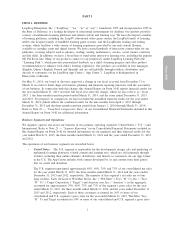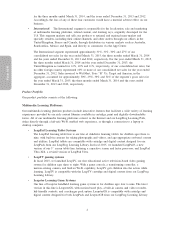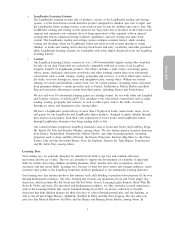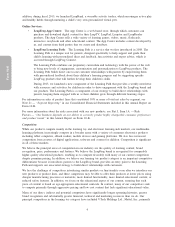LeapFrog 2015 Annual Report Download - page 17
Download and view the complete annual report
Please find page 17 of the 2015 LeapFrog annual report below. You can navigate through the pages in the report by either clicking on the pages listed below, or by using the keyword search tool below to find specific information within the annual report.
ITEM 1A. RISK FACTORS
Our business, financial condition and operating results can be affected by a number of factors, including those
described below, any one of which could cause our actual results to vary materially from recent results or
from our anticipated future results. In addition to other information contained in this Annual Report on
Form 10-K and our other filings with the SEC, the following risk factors should be considered carefully
before you decide whether to buy, hold or sell our common stock. Additional risks not presently known to us
or that we currently deem immaterial may also impair our business, financial conditions, results of operations
and stock price.
Our business depends on our ability to correctly predict highly changeable consumer preferences and
product trends.
The preferences and interests of children and families evolve quickly, can change drastically from year to year
and are difficult to predict. Even our successful products typically have a relatively short period of high
demand followed by a decrease in demand as the product matures. We depend on our ability to correctly
identify changing consumer sentiments well in advance and supply new products that respond to such changes
on a timely basis. We also rely on our ability to identify third-party entertainment media that is likely to be
popular with consumers and license rights to such media to incorporate into our products. In addition, we
need to be able to accurately forecast sales of these products in order to optimize our production schedules
and manage our inventory. Since our products typically have a long development cycle, in some cases lasting
over a year, it can be difficult to correctly predict changing consumer preferences and accurately forecast
optimal production and sales targets for these products. If we are unable to correctly predict consumer
preferences, successfully integrate popular third-party media with our own or accurately forecast sales targets
for our products, it could negatively impact our current and future operating results. For example, net sales of
our both our LeapPad and LeapTV platforms in fiscal 2015 were below our expectations, resulting in higher
than anticipated inventory levels of the products at fiscal year-end and operating results that substantially
underperformed our expectations.
To remain competitive and stimulate consumer demand, we must continue to develop new products and
services and successfully manage frequent product introductions and transitions.
Due to the highly volatile and competitive nature of the industries in which we compete, we must continually
introduce new products and services, enhance existing products and services, and effectively stimulate
customer demand for new and upgraded products. We cannot be sure that any new products or services will
be widely accepted and purchased by consumers or that we will be able to successfully manage product
introductions and transitions. Failure by consumers to accept our new products and services or to pay a higher
price for some of our key products, or our failure to manage product introductions and transitions, could
adversely affect our operating results. For example, consumer demand and acceptance of our LeapTV platform
in fiscal 2015 was below our expectations, resulting in higher than anticipated inventory levels of the product
at year end and contributing to our lower than anticipated financial results.
If inventory levels are too high, or if we do not maintain sufficient inventory levels to deliver our
products to our customers in sufficient quantities, or on a timely basis, or our operating results will be
adversely affected.
The high degree of seasonality of our business places stringent demands on our product planning, inventory
forecasting and production planning processes. This inventory management approach may be particularly
challenging when combined with ‘‘just-in-time’’ inventory management systems commonly used by retailers to
minimize their inventory levels. If we fail to meet tight shipping schedules, we could damage our relationships
with retailers, increase our shipping costs or cause sales opportunities to be delayed or lost. In order to be able
to deliver our merchandise on a timely basis, we need to maintain adequate inventory levels of the desired
products. This requires us to begin to place orders for components up to a year in advance, and we produce a
significant amount of product months in advance, of the holiday season. At the time these orders are being
placed and product is being produced, we generally do not have firm orders from retailers or a complete
understanding of what the consumer demand for those products will be in the holiday season. If our product
planning, inventory forecasting and production planning processes result in our manufacturing inventory in
10
























